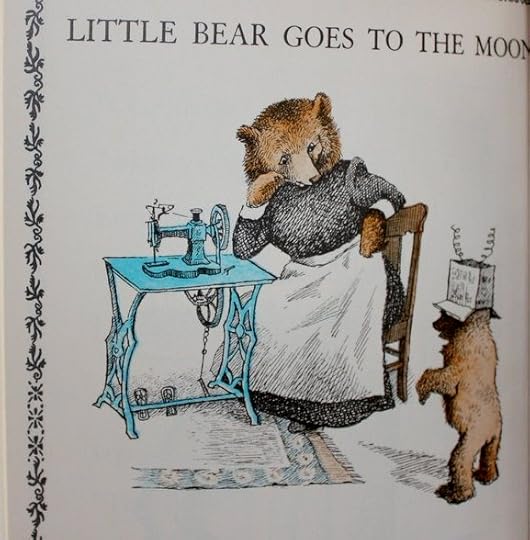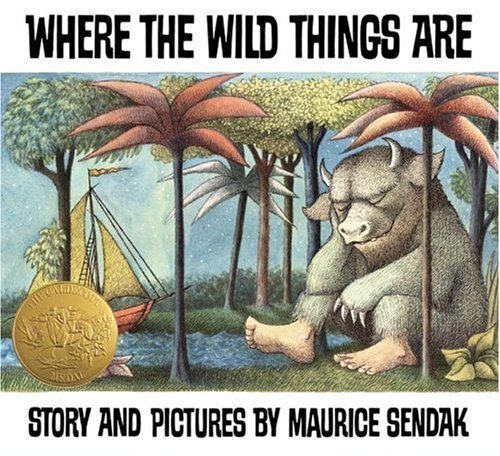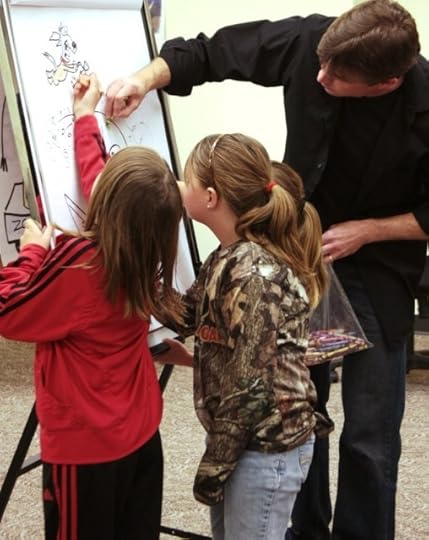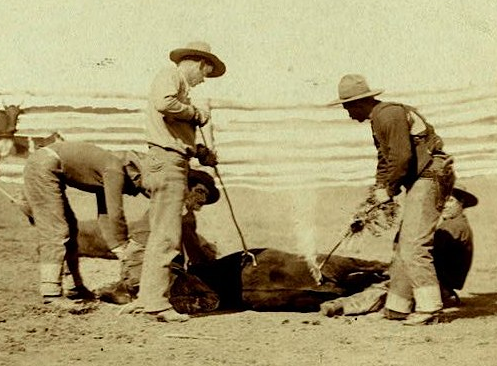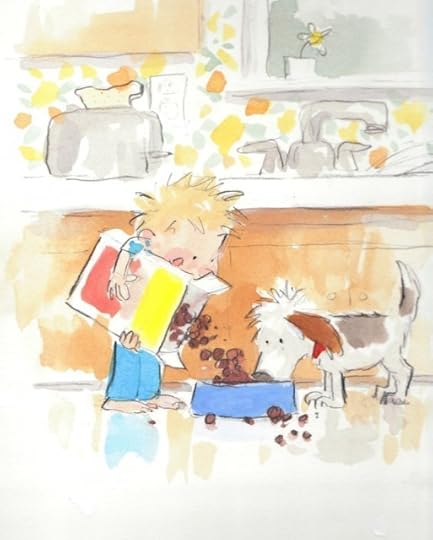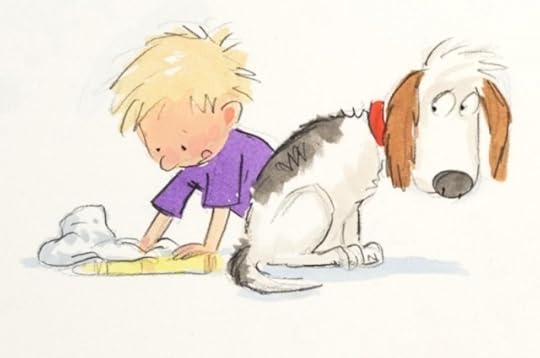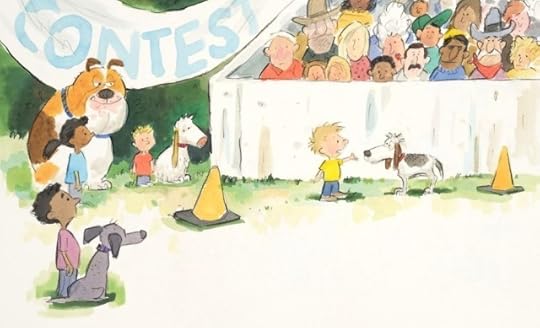David Slonim's Blog, page 5
May 8, 2012
A Tribute to Maurice Sendak
Maurice Sendak‘s illustrations for Little Bear, written by Else Holmelund Minarik, creeped me out when I was very young. Especially the story about Little Bear pretending to go to the moon. For me, it was kiddie Twilight Zone. Sendak’s cross-hatched images of Little Bear and his mother on spare white backgrounds created a deeply unsettling mood I’ll never forget.
When I grew up, he became a mentor by example. The man loved his craft. Look at the details in this illustration the specificity of the sewing machine with all its parts lovingly described, the piping on the mother’s dress at the shoulder, the little notch in the chair back, the very bearish anatomy of Little Bear’s arms and legs. Little Bear’s face is thrown into dark shadow as his mother pretends not to know him. CREEPY!
That was the magic in his work — a mood, a flavor, an energy– that grabbed me by the jugular.
Here’s one from Where the Wild Things Are. I’m struck again by how specific and unique the objects are. The railing post with its decorative top — that’s not a generic place-holder for “stair railing.” Same with the fork. You could send somebody to the kitchen to get that fork - “you know, the one with the long, skinny handle, big flat scoop and four prongs.” Even the wall trim is unique. He lavished attention on details. And that cross- hatch induced dream state… Wow! Max is simultaneously leaping wildly and absolutely frozen motionless in time. Sheer brilliance.
 Chicken Soup with Rice is my favorite, probably because I can still hear my mother’s voice as I read it. We spent a lot of time together with this one.
Chicken Soup with Rice is my favorite, probably because I can still hear my mother’s voice as I read it. We spent a lot of time together with this one.
Maurice Sendak spoke at Rhode Island School of Design while I was a student there. Twenty six years later, I vividly remember two things he shared:
1) Books smell good. (The man loved the smell of a book. He was not ashamed at all about this simple pleasure. Made a big point of this in his talk). I took it as permission to delight in the physical materials of my craft.
2) Illustrate BETWEEN the lines. Don’t simply echo the text– enhance it, augment it. If the illustration simply repeats information already given by the text, what’s the point? This pearl of wisdom has guided me for 16 years of visual story telling in children’s books.
On hearing the news of his passing today, I felt what all of us working in the book world are feeling — we’ve lost a giant.
I’m grateful to have been exposed to his work as a child. He helped to shape my intellectual and emotional worlds. As an art student in the mid 1980′s, eager for reports from the front lines, it was a privilege to hear him speak about the craft. He shaped my thinking about the responsibility of picture-making.
Thousands and thousands of us feel the same way. He made vines grow up in our minds, boats carry us for a year and a day, taking us to places we are better for having visited.
Long ago, Maurice Sendak started a wild rumpus. Along with all his fans everywhere, I intend to do my part to keep it going.
Maurice Sendak (1928-2012)

April 11, 2012
Thanks, Rising Sun Elementary School!
The kids at Rising Sun Elementary were enthusiastic and full of energy. Rising Sun, IN is a quiet little town on the Ohio River, but inside the Ohio County Public Library yesterday, we were making some noise! We sang a little opera at the top of our lungs as a gift to their teachers, screamed like a terrified goldfish about to be swallowed, (another gift for their teachers), talked about working hard and not giving up when things go wrong, and designed characters together.
After a power point presentation that is packed with information and encouragement for the whipper-snappers, we pretend we are a major design studio designing a character for a new movie. Starting with a blank pad and a marker, I ask the kids three questions:
1. What kind of character is it? (human, animal, inanimate object, imaginary, etc)
2. What problem is the character having?
3. What emotion is the character feeling?
After I rapidly draw the character in the situation dreamed up by the audience, three kids help color it.
I spoke to three groups of students, 2nd – 4th graders. Here are some photos from the day:
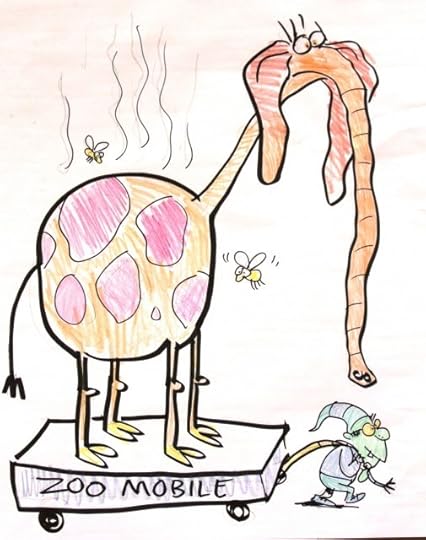
"A Girelephantaffe With Flies Being Pulled to the Zoo by an Elf"
The drawings take about five minutes to brainstorm, and five minutes to draw and color.
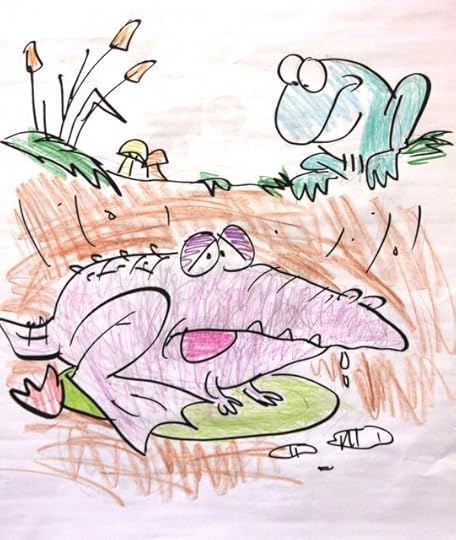
"A Frogodile Feeling Sick Because it Drank All The Pond Water."

"A Dog on a Dirt Bike on the Moon Being Chased by an Alien Polar Bear"

coloring the picture together
I brought some original artwork:
Thank you, Rising Sun Elementary. I had a great time with you. Special thanks to Cynthia Schmid-Perry, Library Director, Ohio Co. Public Library, for inviting me and organizing the visit.
…………………………………………………………………………………………………………………………..
Speaking to kids about life as a professional artist is one of the most fun parts of my job. Presentations are fun, upbeat, and packed with encouragement and information:
Shhh! Studio Secrets: Goof-ups and Do-overs
Creative Process: From Idea to Finished Art
Fine Art and Children’s Book Art- A Love Story
Character Design Group Project and Demo
What to Do When It Doesn’t Come Out Right
Your Questions Answered
If you’d like to schedule a school visit, please use the contact page. Thanks.

March 26, 2012
Barn Sketches

Howell's Barn, sketch A | charcoal
Here are a few quick sketches done earlier this year. Drawing in vine charcoal helps me learn to translate what I’m seeing into line and mass. It also makes it easy to design in three values– light, medium and dark.

Howell's Barn, sketch B | charcoal
Same subject as the first sketch, slightly different way of seeing it.

Howell's Building Cluster A | charcoal
This last one plays around with spacial relationships – how much “sky” vs how much “building cluster”, etc.
Drawing in charcoal speeds up the decision-making process, allowing rapid development of dark, medium and light value zones. The backbone of a strong painting is already in place once you come up with a strong charcoal drawing.
For fixative I recommend Utrecht brand. It’s called “Workable Fixative”, comes in a spray can. It’s the only brand I’ve found that does not have a yellowish tint.

February 28, 2012
SLUGGER- Pencil Sketches
February 9, 2012
Art, Grapefruit, and Connection

The Wishing Well | 24 x 30 oil, Private Collection
A collector friend who happens to live in town asked me to bring some new works by his place a couple of weeks ago. Above his kitchen table hangs this painting. When he bought it several years back, he asked me to put an extra coat of varnish on it. “I like grapefruit,” he explained with a smile. “It tends to squirt.”
It’s hard to describe what an honor it is when someone chooses to make a painting part of their home. This guy likes grapefruit, and he likes my painting — hanging right over his breakfast table so he can enjoy it every morning.
Visiting Jack reminded me why I paint. It’s about giving a gift to the viewer. That connection is, of course, a gift to the artist also.
If somebody enjoys your work, be encouraged. If they have chosen to live with it, (even a reproduction of it), as part of their daily life, you have achieved the ultimate honor for an artist.
Somebody needs the art you are about to make. Keep going…

February 6, 2012
Branding Your Cow by Eric Rhoads
Branding Your Cow
The Importance of Branding in the Sale of Art
A Marketing Message from Art Publisher Eric Rhoads
Moos of panic filled the dusty air as cowboys pressed the hot branding iron against the flesh of the cattle out West. This painful exercise, branding, served the purpose of marking ownership of the cow. But the mark on the cow was less important than the reputation of the rancher. For instance, cattle rustlers knew which farmers would overlook the loss of an occasional cow and which were so tough they would hang cattle thieves on sight. Rustlers would avoid stealing cattle with certain brands. The behavior of the rancher became the meaning of the brand.
If you’re marketing art, you’ve probably heard a lot about branding, and you may be wondering how it relates to you. We know companies like Apple, Coke, and McDonald’s have the most recognizable brands, but those brands also have meaning. For instance, the McDonald’s brand means consistent quality and fast service.
Think about the meaning of each of these brands.
Harley-Davidson: Loud, thunderous mufflers, radical, non-conforming
Apple: Innovation
Louis Vuitton: Elegance
Walmart: Lowest prices
Target: Low prices with style
Smart marketers seek to define a brand and make everything they do a relentless reinforcement of that image. Once established, a brand never, ever changes.
If I were to ask art collectors for the names of the most successful artists who command the highest prices, I would hear the same names, over and over. Though there may be painters whose quality of work is equal to or better than those top names, they cannot command the same prices and see little demand for their artwork because their brands are not strong in the eyes of the collectors. I could also ask art collectors for the names of the most successful galleries in the world, and they would cite the same top galleries.
A Strong Brand = Goals Achieved
A strong, quality brand brings higher prices because the brand gives buyers confidence. I know a dealer who recently commanded a premium of about 40 percent for paintings he sold — though collectors could buy equally good paintings, from the same artists, from other dealers for less money. The brand of this dealer is so strong that collectors feel more comfortable buying from him, knowing they won’t get a fraud, knowing he will stand behind them, and knowing he always finds the best paintings.
Galleries with strong brands have worked tirelessly to make sure everything they do is a reinforcement of that brand. If the brand is about top price and top quality, you will never see that gallery running a sale. These owners invest in elaborate decor for their galleries and have elegant locations in the best neighborhoods, giving confidence to high-end art buyers.
Branding Is Either Controlled or Accidental
Think of your brand as the position you hold in the mind of the potential buyer. If you have a brand at all, either you have defined it intentionally or it has been created for you, unintentionally. If you show up drunk at openings and you look like a slob, that becomes the image others have of your brand. If you drive a Bentley and are a natty dresser, you’re sending a signal of success.
But brand isn’t just about appearance, it’s about the whole of what you project over a long period of time. It’s about the quality of your work, the frames you use, the people you’re known to associate with, your politics, the pictures and opinions you post on Facebook, the look and design of your ads and brochures, and everything else seen by the public. Smart brands rarely broadcast their opinions about religion or politics because that’s an automatic turn-off to a large portion of the buying public (though a few brands are all about being radical, irreverent, or political). Sometimes a brand position isn’t about original art sales at all, but about other goals, like acceptance into major museums, selling prints, obtaining licensing deals, or just getting press.
Are You Walmart or Lexus?
One of the keys to brilliant success starts with defining what you want your brand to be and how you will project and reinforce it. What about you? Are you in control of your brand? Is every touchpoint a reinforcement of that brand? What is your brand? Does it accomplish what you need it to accomplish? Does it match the perceptions you need from the people you want as customers? Are you Walmart or Lexus? Each position is valuable, depending on whom you’re targeting and the desired end result.
One of Three Brand Positions
Even if you’ve never stopped to think about your brand, you have one of three brand positions. You are either unknown and have no brand, or you have a brand you’ve intentionally created, or you have a brand that has been created for you by others.
Do you have a brand? Do you know how others perceive your brand? Is it accomplishing the desired result? If you have no brand yet, you have the potential to build one. If your brand isn’t accomplishing your goals, you have the potential for re-branding.
Finding Brand Clarity
Branding is critical to the success of any business or product, including artists and art galleries, but branding is a tactic, based on a solid marketing strategy that is rooted in knowing your exact goals. Once you understand where you want to be and what you need to accomplish, the brand position you need to take will become clear.
For instance, if you need highly affluent people to buy your artwork, you need to determine a brand position you can own in their minds and develop a step-by-step process to build that position. (Branding is a long-term process; it takes lots of repetition over time.)
For some, it’s too much effort to think about creating or managing a brand — and as a result, their careers will go whichever way the wind is blowing. For others who have specific goals, branding is a critical process that requires a branding plan.
What about you? Does everything you do reflect your brand? Your website, your ads, your business cards, your appearance, and your representatives? Can the people you are targeting reflect your position back to you, or does it exist only in your mind? Implementing a solid branding plan is one of the many critical keys to success as an artist. It’s worth thinking about if you’re not where you want to be.
…………………………………………………………………………………………………………….
Republished by permission. B. Eric Rhoads is publisher of Fine Art Connoisseur and Plein Air magazines and is conducting his marketing bootcamp at the PleinAir convention. You can find his art blog at http://ericrhoads.blogs.com/artist_marketing/

January 27, 2012
PATCH Art Sneak Peek
The art for PATCH shipped today. Here’s a small sample of what’s in the box -
This is the project I wrote about earlier this week– the one I started over after painting the whole book last week. Boy, am I glad I repainted it. Much better.
Now it’s heading to New York-
……………………………………………………………………………………………………
PATCH by David Slonim To be published by Roaring Brook Press (MacMillan), 2013.

David Slonim's Blog
- David Slonim's profile
- 25 followers


